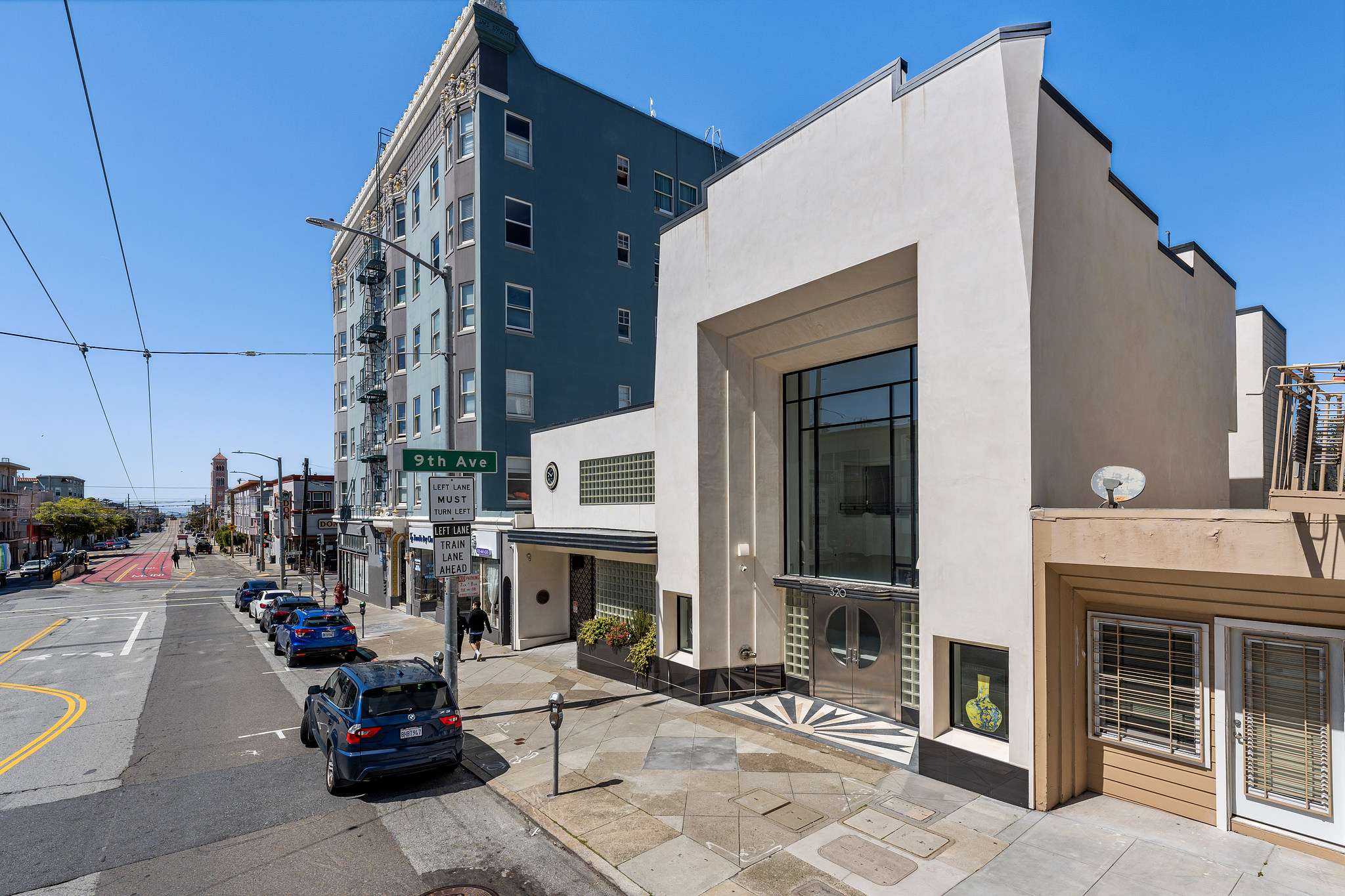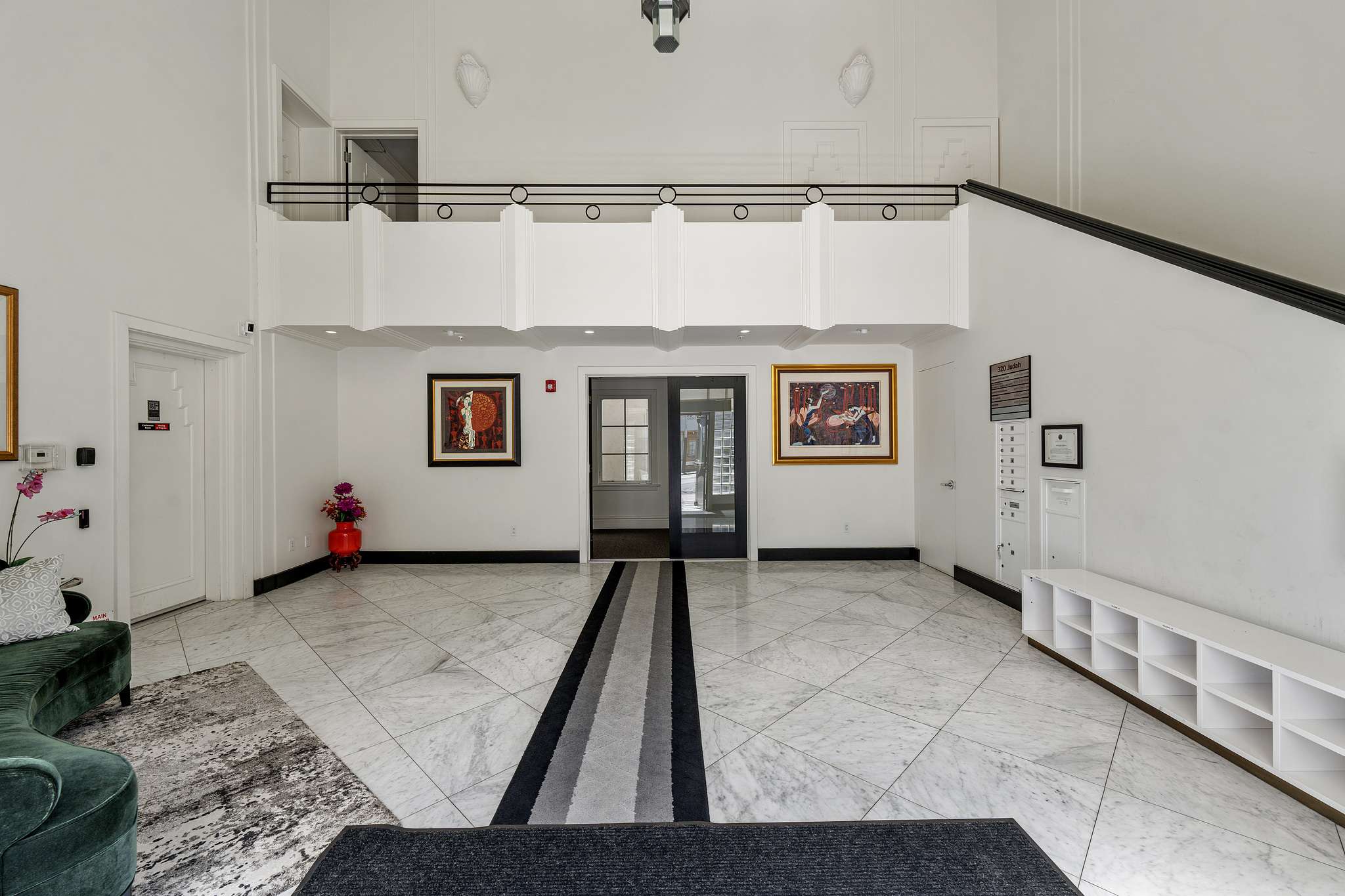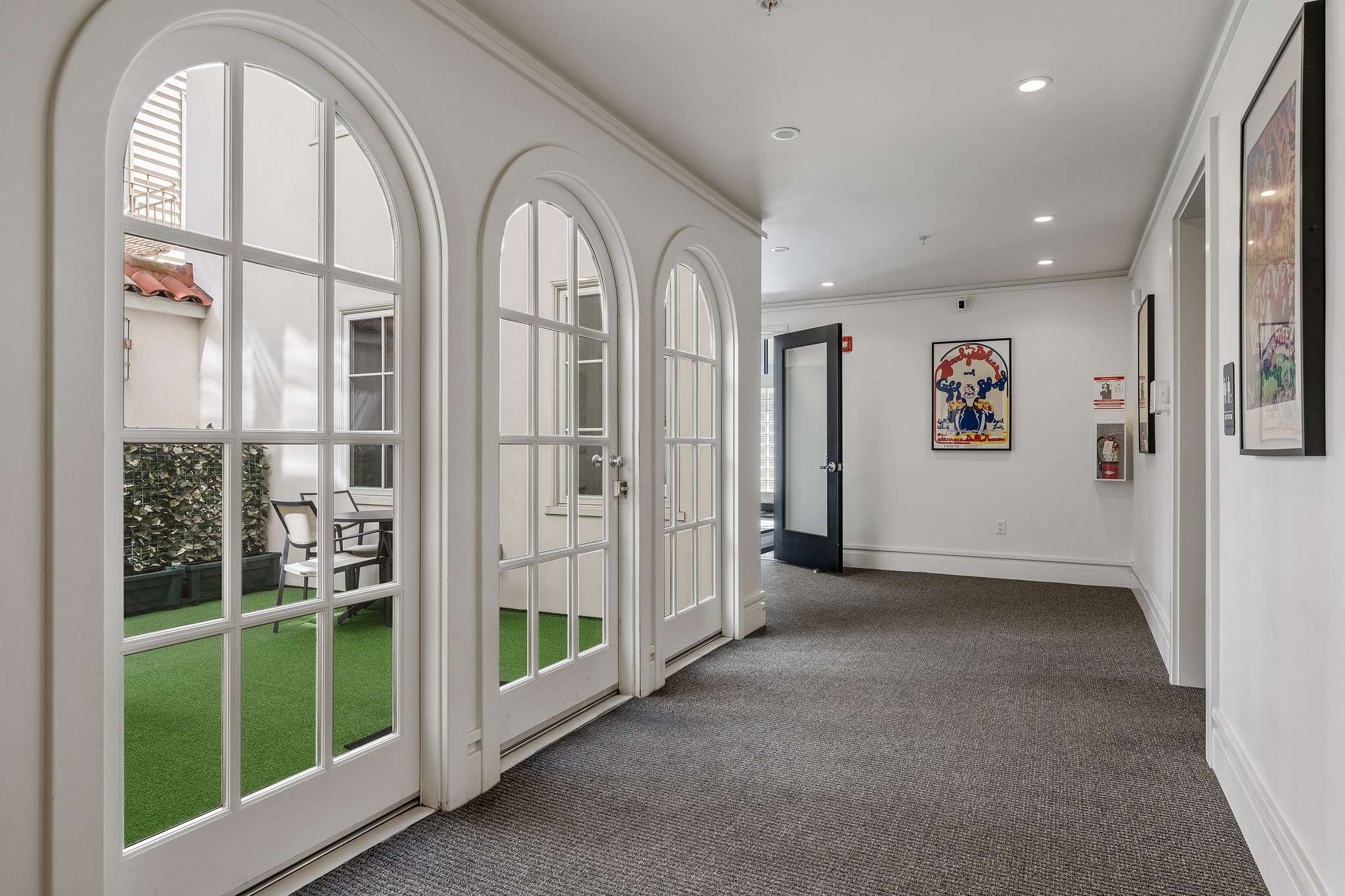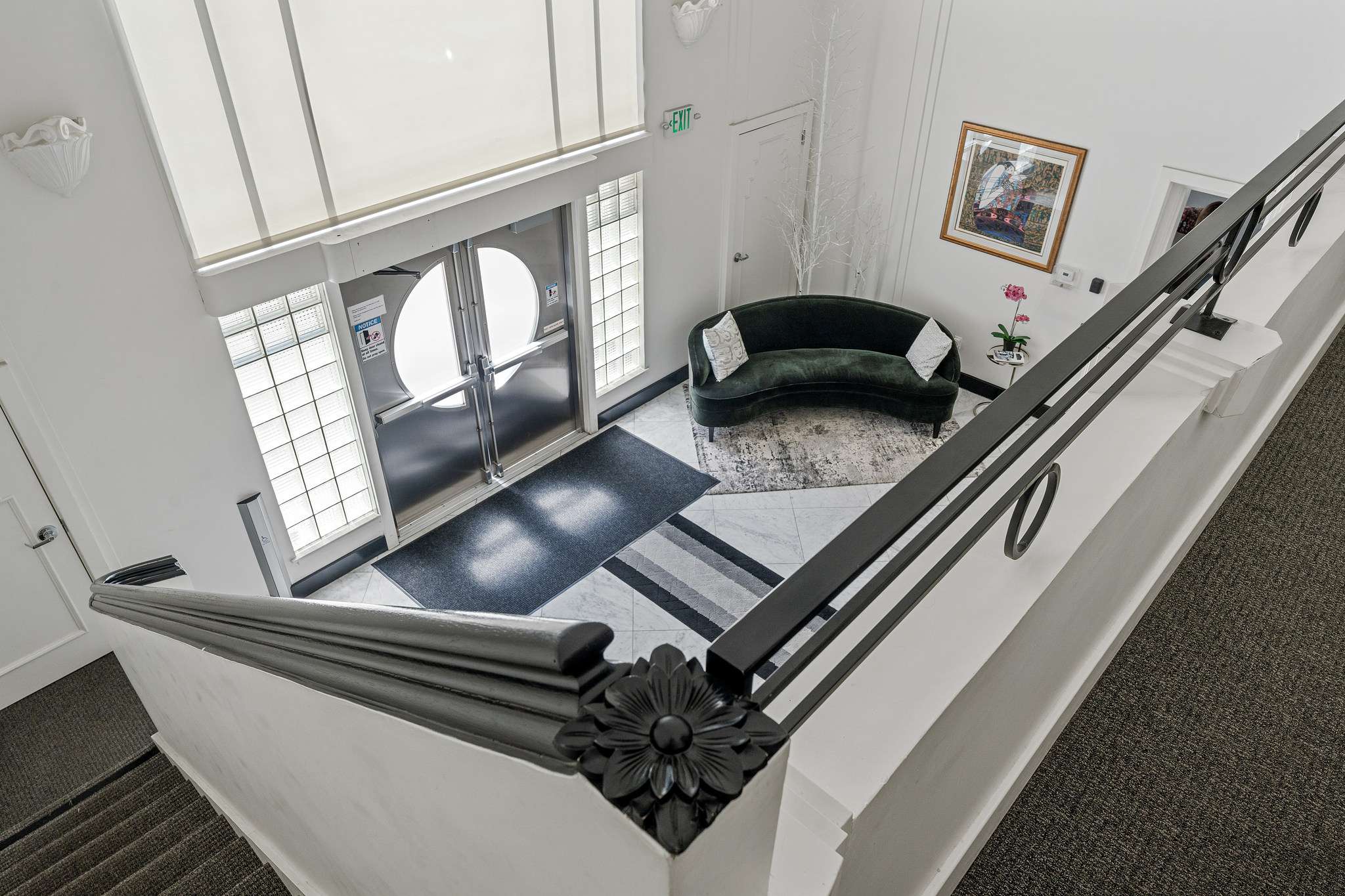Menu

Prime Office Space Available for Lease inside the Art Deco Historic Doelger Building
320 Judah Street
Addie Kwan Presents
All Property Photos
Property Tour
Property Details
The Doelger Building is a cherished landmark in San Francisco's architectural history, blending bold Art Deco and Streamline Moderne design. Located at 320 Judah Street in the vibrant Inner Sunset neighborhood, this historic gem seamlessly combines iconic architectural details with modern amenities. The Henry Doelger Building features functional office spaces with abundant natural light and stylish common areas. Enjoy a lush courtyard, the walkable charm of the Inner Sunset, and easy access to transit, dining, and more—making it the perfect location for businesses seeking a distinctive, comfortable, and stylish work environment.
Fully restored and meticulously renovated in 2015, the building offers modern commercial office spaces designed for today’s businesses. With contemporary amenities and its unique architectural charm, the Doelger Building provides an ideal location for those seeking a distinctive workspace with both character and convenience.
Highlights:
Fully restored and meticulously renovated in 2015, the building offers modern commercial office spaces designed for today’s businesses. With contemporary amenities and its unique architectural charm, the Doelger Building provides an ideal location for those seeking a distinctive workspace with both character and convenience.
Highlights:
- Historic Art-Deco Landmark: Meticulously renovated and modernized in 2015, preserving its fascinating history.
- Natural Light: Large windows ensure abundant natural light.
- Spacious Layout: Open floor plan, ready for immediate move-in.
- Energy Efficiency: Equipped with LED ceiling lights and radiant in-floor heating system.
- Restrooms: Access to four common area restrooms including an ADA-compliant restroom with a shower.
- Security: State-of-the-art locking system and 24/7 video surveillance in common areas and outside the building.
- Safety: The building is seismically retrofitted and equipped with an electronically monitored fire sprinkler system with a separate alarm connected to the S.F. Fire Department.
- High-Capacity Power: 900 AMP three-phase electrical supply
- Prime Location: Just one block from the vibrant heart of San Francisco's Inner Sunset at 9th Avenue and Irving Street, a bustling commercial hub with artisan restaurants, culinary boutiques, retail shops, bookstores, art galleries, and more. Conveniently close to UCSF and prominent landmarks, including top-rated attractions like the San Francisco Botanical Garden, De Young Museum, and The California Academy of Science.
- Proximity to Golden Gate Park: Just two blocks away, with jogging and bike trails, picnic spots, and recreational facilities, perfect for workday breaks and team activities.
- Prime Transit Access: Located just steps from the famous N-Judah streetcar, enjoy a quick 25-minute from Powell BART Station (Market & 5th) to 9th Avenue & Judah. Whether you're commuting from the East Bay via BART (30 minutes from Embarcadero Center Station) or from the Peninsula (a 51-mile route between San Francisco and San Jose) via Caltrain (40 minutes from 4th & King Station), the N-Judah line is easily accessible from both stations. Additionally, Muni bus routes 6, 43, 44, and 66 are less than a block away.
- Seamless Driving Access: Convenient for drivers coming from Marin and the North Bay via the Golden Gate Bridge, or from the South Bay and SFO via I-280 and Highway 1.
- Responsive Management: Experience Personalized service, flexible lease terms, and quick decision-making, all with a focus on excellent maintenance and clear, direct communication to ensure a well-maintained office environment.
| Rent Type | Multi-Tenant Office - Gross | ||
| 1,426 rentable square feet | ||
| Available upon request | ||
| Space Use |
| ||
| Term | Flexible lease terms | ||
| Year Built | 1932/1940 | ||
| Cross Street |
|
A Colorful History
The Legacy of Henry Doelger and the Doelger Building
In January 1932, Henry Doelger hired architect, Charles O. Clausen to design a headquarter for his construction firm, warehouse, and sales office at 320 Judah Street. This building became a notable landmark in the Sunset District and served as Doelger’s operational base for two decades. At the time, it was one of the first modern buildings in the neighborhood and advertised Doelger’s thriving house-building empire.
From the mid-1920s to the 1940s, Henry Doelger built thousands of single-family houses above the sand dunes in San Francisco’s Sunset District. By the 1930s and early 1940s, his company, Henry Doelger Builder Inc. dominated the home-building industry in San Francisco. Using Henry Ford “Fordist” principles of mass production in the home building industry, Doelger’s company constructed around 11,000 buildings in San Francisco, primarily in the Sunset District for the working and middle classes. Between 1934 and 1941, Doelger was the largest homebuilder in the United States, building an average of two houses per day and employing 500 people. Today, one can observe numerous single-family houses in the Sunset District that were designed with Henry Doelger’s signature footprint and identical designs.
In 1945, Henry Doelger acquired a significant tract of land in San Mateo County, south of San Francisco. Over the next twenty years, he developed the area into the renowned Westlake subdivision in Daly City, building approximately 6,500 single-family houses, 3,000 apartments, architect-designed public schools, and a 40-acre shopping center. Doelger planned Westlake from his offices at 320-326 Judah Street until his departure in 1950.
Another Prominent Figure in Real Estate: Cleland Whitton and 320 Judah
On April 26, 1951, Cleland O. Whitton, a well-known real estate and banker figure, bought 320-326 Judah Street from Henry Doelger. He then occupied his real estate development firm in the building.
Cleland Whitton was a San Francisco resident from 1923 to April 1963, having held several prominent positions. He was the president of the Real Estate Association of San Francisco in 1946, and the founding and first president of the Multiple Listing Service of San Francisco in 1949, and 1950. In 1950, Cleland was honored for his service to the San Francisco real estate community by a proclamation of the San Francisco Board of Supervisors and with a banquet at the Palace Hotel.
He was also president of the board of the Stonestown YMCA in the 1950s. Additionally, Cleland Whitton was one of the founders of the former Colonial Savings & Loan Association of San Francisco, a member of the Olympic Club for over 50 years, and the former president of the West O' Twin Peak Lions Club. He was a longtime board member of the Lions Eye Foundation in the 1970s and '80s.
After Cleland Whitton purchased the Doelger Building, it housed a variety of professional service providers, including an accountant, insurance broker, and architect Martin Rist (an acclaimed architect who designed public buildings). Later, other tenants moved in, including the International Agriculture Service and the Berryessa Land Sales firm.
1960s Artistic Movement and The Doelger Building
The Doelger building at 320 Judah Street played a vital role in the emerging psychedelic rock scene in San Francisco during the 1960s. According to a reliable source, a founding member of the first psychedelic rock band had an office in the building and was deeply involved in the local music scene. Additionally, the building served as storage space for equipment and rehearsal studios for many San Francisco-based bands.
In February 1970, a well-known American manufacturer of high-end electric basses, guitars, and preamps that improved the quality of live sound and concert recordings moved its headquarters to the Doelger Building. As part of a famous rock band’s road crew, the company provided sound equipment for renowned bands.
A well-known graphic artist and photographer once occupied a photography studio on the building’s second floor, where Janis Joplin’s “Beads” photograph is believed to have been taken and developed.
Preserving History: The Transformation of 320 Judah into a Modern Landmark
In 2012, TDW LLC acquired 320 Judah and their invaluable contributions to its renovation have transformed the building into a modern landmark while preserving its unique historical characteristics. The extensive and meticulous renovation successfully blended historical charm with contemporary elements, greatly enhancing the property. This remarkable transformation led to its recognition as "One of the best Historic Building upgrades in the City", and on April 10, 2013, the Historic Preservation Commission granted 320 Judah the prestigious status of a San Francisco Historical Landmark. The building showcases dual architectural styles, with the original vertical section (East Side), constructed in 1932, featuring Art Deco design. Additionally, a horizontal addition (West Side) was constructed in 1940, expanding the building's street frontage and highlighting the distinctive Streamline Moderne style.
Overall, the rich history, meticulous renovation, historical recognition, and harmonious architectural blend have made 320 Judah an exceptional property.
In January 1932, Henry Doelger hired architect, Charles O. Clausen to design a headquarter for his construction firm, warehouse, and sales office at 320 Judah Street. This building became a notable landmark in the Sunset District and served as Doelger’s operational base for two decades. At the time, it was one of the first modern buildings in the neighborhood and advertised Doelger’s thriving house-building empire.
From the mid-1920s to the 1940s, Henry Doelger built thousands of single-family houses above the sand dunes in San Francisco’s Sunset District. By the 1930s and early 1940s, his company, Henry Doelger Builder Inc. dominated the home-building industry in San Francisco. Using Henry Ford “Fordist” principles of mass production in the home building industry, Doelger’s company constructed around 11,000 buildings in San Francisco, primarily in the Sunset District for the working and middle classes. Between 1934 and 1941, Doelger was the largest homebuilder in the United States, building an average of two houses per day and employing 500 people. Today, one can observe numerous single-family houses in the Sunset District that were designed with Henry Doelger’s signature footprint and identical designs.
In 1945, Henry Doelger acquired a significant tract of land in San Mateo County, south of San Francisco. Over the next twenty years, he developed the area into the renowned Westlake subdivision in Daly City, building approximately 6,500 single-family houses, 3,000 apartments, architect-designed public schools, and a 40-acre shopping center. Doelger planned Westlake from his offices at 320-326 Judah Street until his departure in 1950.
Another Prominent Figure in Real Estate: Cleland Whitton and 320 Judah
On April 26, 1951, Cleland O. Whitton, a well-known real estate and banker figure, bought 320-326 Judah Street from Henry Doelger. He then occupied his real estate development firm in the building.
Cleland Whitton was a San Francisco resident from 1923 to April 1963, having held several prominent positions. He was the president of the Real Estate Association of San Francisco in 1946, and the founding and first president of the Multiple Listing Service of San Francisco in 1949, and 1950. In 1950, Cleland was honored for his service to the San Francisco real estate community by a proclamation of the San Francisco Board of Supervisors and with a banquet at the Palace Hotel.
He was also president of the board of the Stonestown YMCA in the 1950s. Additionally, Cleland Whitton was one of the founders of the former Colonial Savings & Loan Association of San Francisco, a member of the Olympic Club for over 50 years, and the former president of the West O' Twin Peak Lions Club. He was a longtime board member of the Lions Eye Foundation in the 1970s and '80s.
After Cleland Whitton purchased the Doelger Building, it housed a variety of professional service providers, including an accountant, insurance broker, and architect Martin Rist (an acclaimed architect who designed public buildings). Later, other tenants moved in, including the International Agriculture Service and the Berryessa Land Sales firm.
1960s Artistic Movement and The Doelger Building
The Doelger building at 320 Judah Street played a vital role in the emerging psychedelic rock scene in San Francisco during the 1960s. According to a reliable source, a founding member of the first psychedelic rock band had an office in the building and was deeply involved in the local music scene. Additionally, the building served as storage space for equipment and rehearsal studios for many San Francisco-based bands.
In February 1970, a well-known American manufacturer of high-end electric basses, guitars, and preamps that improved the quality of live sound and concert recordings moved its headquarters to the Doelger Building. As part of a famous rock band’s road crew, the company provided sound equipment for renowned bands.
A well-known graphic artist and photographer once occupied a photography studio on the building’s second floor, where Janis Joplin’s “Beads” photograph is believed to have been taken and developed.
Preserving History: The Transformation of 320 Judah into a Modern Landmark
In 2012, TDW LLC acquired 320 Judah and their invaluable contributions to its renovation have transformed the building into a modern landmark while preserving its unique historical characteristics. The extensive and meticulous renovation successfully blended historical charm with contemporary elements, greatly enhancing the property. This remarkable transformation led to its recognition as "One of the best Historic Building upgrades in the City", and on April 10, 2013, the Historic Preservation Commission granted 320 Judah the prestigious status of a San Francisco Historical Landmark. The building showcases dual architectural styles, with the original vertical section (East Side), constructed in 1932, featuring Art Deco design. Additionally, a horizontal addition (West Side) was constructed in 1940, expanding the building's street frontage and highlighting the distinctive Streamline Moderne style.
Overall, the rich history, meticulous renovation, historical recognition, and harmonious architectural blend have made 320 Judah an exceptional property.
The Legacy of Henry Doelger and the Doelger Building
In January 1932, Henry Doelger hired architect, Charles O. Clausen to design a headquarter for his construction firm, warehouse, and sales office at 320 Judah Street. This building became a notable landmark in the Sunset District and served as Doelger’s operational base for two decades. At the time, it was one of the first modern buildings in the neighborhood and advertised Doelger’s thriving house-building empire.
From the mid-1920s to the 1940s, Henry Doelger built thousands of single-family houses above the sand dunes in San Francisco’s Sunset District. By the 1930s and early 1940s, his company, Henry Doelger Builder Inc. dominated the home-building industry in San Francisco. Using Henry Ford “Fordist” principles of mass production in the home building industry, Doelger’s company constructed around 11,000 buildings in San Francisco, primarily in the Sunset District for the working and middle classes. Between 1934 and 1941, Doelger was the largest homebuilder in the United States, building an average of two houses per day and employing 500 people. Today, one can observe numerous single-family houses in the Sunset District that were designed with Henry Doelger’s signature footprint and identical designs.
In 1945, Henry Doelger acquired a significant tract of land in San Mateo County, south of San Francisco. Over the next twenty years, he developed the area into the renowned Westlake subdivision in Daly City, building approximately 6,500 single-family houses, 3,000 apartments, architect-designed public schools, and a 40-acre shopping center. Doelger planned Westlake from his offices at 320-326 Judah Street until his departure in 1950.
Another Prominent Figure in Real Estate: Cleland Whitton and 320 Judah
On April 26, 1951, Cleland O. Whitton, a well-known real estate and banker figure, bought 320-326 Judah Street from Henry Doelger. He then occupied his real estate development firm in the building.
Cleland Whitton was a San Francisco resident from 1923 to April 1963, having held several prominent positions. He was the president of the Real Estate Association of San Francisco in 1946, and the founding and first president of the Multiple Listing Service of San Francisco in 1949, and 1950. In 1950, Cleland was honored for his service to the San Francisco real estate community by a proclamation of the San Francisco Board of Supervisors and with a banquet at the Palace Hotel.
He was also president of the board of the Stonestown YMCA in the 1950s. Additionally, Cleland Whitton was one of the founders of the former Colonial Savings & Loan Association of San Francisco, a member of the Olympic Club for over 50 years, and the former president of the West O' Twin Peak Lions Club. He was a longtime board member of the Lions Eye Foundation in the 1970s and '80s.
After Cleland Whitton purchased the Doelger Building, it housed a variety of professional service providers, including an accountant, insurance broker, and architect Martin Rist (an acclaimed architect who designed public buildings). Later, other tenants moved in, including the International Agriculture Service and the Berryessa Land Sales firm.
1960s Artistic Movement and The Doelger Building
The Doelger building at 320 Judah Street played a vital role in the emerging psychedelic rock scene in San Francisco during the 1960s. According to a reliable source, a founding member of the first psychedelic rock band had an office in the building and was deeply involved in the local music scene. Additionally, the building served as storage space for equipment and rehearsal studios for many San Francisco-based bands.
In February 1970, a well-known American manufacturer of high-end electric basses, guitars, and preamps that improved the quality of live sound and concert recordings moved its headquarters to the Doelger Building. As part of a famous rock band’s road crew, the company provided sound equipment for renowned bands.
A well-known graphic artist and photographer once occupied a photography studio on the building’s second floor, where Janis Joplin’s “Beads” photograph is believed to have been taken and developed.
Preserving History: The Transformation of 320 Judah into a Modern Landmark
In 2012, TDW LLC acquired 320 Judah and their invaluable contributions to its renovation have transformed the building into a modern landmark while preserving its unique historical characteristics. The extensive and meticulous renovation successfully blended historical charm with contemporary elements, greatly enhancing the property. This remarkable transformation led to its recognition as "One of the best Historic Building upgrades in the City", and on April 10, 2013, the Historic Preservation Commission granted 320 Judah the prestigious status of a San Francisco Historical Landmark. The building showcases dual architectural styles, with the original vertical section (East Side), constructed in 1932, featuring Art Deco design. Additionally, a horizontal addition (West Side) was constructed in 1940, expanding the building's street frontage and highlighting the distinctive Streamline Moderne style.
Overall, the rich history, meticulous renovation, historical recognition, and harmonious architectural blend have made 320 Judah an exceptional property.
In January 1932, Henry Doelger hired architect, Charles O. Clausen to design a headquarter for his construction firm, warehouse, and sales office at 320 Judah Street. This building became a notable landmark in the Sunset District and served as Doelger’s operational base for two decades. At the time, it was one of the first modern buildings in the neighborhood and advertised Doelger’s thriving house-building empire.
From the mid-1920s to the 1940s, Henry Doelger built thousands of single-family houses above the sand dunes in San Francisco’s Sunset District. By the 1930s and early 1940s, his company, Henry Doelger Builder Inc. dominated the home-building industry in San Francisco. Using Henry Ford “Fordist” principles of mass production in the home building industry, Doelger’s company constructed around 11,000 buildings in San Francisco, primarily in the Sunset District for the working and middle classes. Between 1934 and 1941, Doelger was the largest homebuilder in the United States, building an average of two houses per day and employing 500 people. Today, one can observe numerous single-family houses in the Sunset District that were designed with Henry Doelger’s signature footprint and identical designs.
In 1945, Henry Doelger acquired a significant tract of land in San Mateo County, south of San Francisco. Over the next twenty years, he developed the area into the renowned Westlake subdivision in Daly City, building approximately 6,500 single-family houses, 3,000 apartments, architect-designed public schools, and a 40-acre shopping center. Doelger planned Westlake from his offices at 320-326 Judah Street until his departure in 1950.
Another Prominent Figure in Real Estate: Cleland Whitton and 320 Judah
On April 26, 1951, Cleland O. Whitton, a well-known real estate and banker figure, bought 320-326 Judah Street from Henry Doelger. He then occupied his real estate development firm in the building.
Cleland Whitton was a San Francisco resident from 1923 to April 1963, having held several prominent positions. He was the president of the Real Estate Association of San Francisco in 1946, and the founding and first president of the Multiple Listing Service of San Francisco in 1949, and 1950. In 1950, Cleland was honored for his service to the San Francisco real estate community by a proclamation of the San Francisco Board of Supervisors and with a banquet at the Palace Hotel.
He was also president of the board of the Stonestown YMCA in the 1950s. Additionally, Cleland Whitton was one of the founders of the former Colonial Savings & Loan Association of San Francisco, a member of the Olympic Club for over 50 years, and the former president of the West O' Twin Peak Lions Club. He was a longtime board member of the Lions Eye Foundation in the 1970s and '80s.
After Cleland Whitton purchased the Doelger Building, it housed a variety of professional service providers, including an accountant, insurance broker, and architect Martin Rist (an acclaimed architect who designed public buildings). Later, other tenants moved in, including the International Agriculture Service and the Berryessa Land Sales firm.
1960s Artistic Movement and The Doelger Building
The Doelger building at 320 Judah Street played a vital role in the emerging psychedelic rock scene in San Francisco during the 1960s. According to a reliable source, a founding member of the first psychedelic rock band had an office in the building and was deeply involved in the local music scene. Additionally, the building served as storage space for equipment and rehearsal studios for many San Francisco-based bands.
In February 1970, a well-known American manufacturer of high-end electric basses, guitars, and preamps that improved the quality of live sound and concert recordings moved its headquarters to the Doelger Building. As part of a famous rock band’s road crew, the company provided sound equipment for renowned bands.
A well-known graphic artist and photographer once occupied a photography studio on the building’s second floor, where Janis Joplin’s “Beads” photograph is believed to have been taken and developed.
Preserving History: The Transformation of 320 Judah into a Modern Landmark
In 2012, TDW LLC acquired 320 Judah and their invaluable contributions to its renovation have transformed the building into a modern landmark while preserving its unique historical characteristics. The extensive and meticulous renovation successfully blended historical charm with contemporary elements, greatly enhancing the property. This remarkable transformation led to its recognition as "One of the best Historic Building upgrades in the City", and on April 10, 2013, the Historic Preservation Commission granted 320 Judah the prestigious status of a San Francisco Historical Landmark. The building showcases dual architectural styles, with the original vertical section (East Side), constructed in 1932, featuring Art Deco design. Additionally, a horizontal addition (West Side) was constructed in 1940, expanding the building's street frontage and highlighting the distinctive Streamline Moderne style.
Overall, the rich history, meticulous renovation, historical recognition, and harmonious architectural blend have made 320 Judah an exceptional property.
Addie Kwan
Showings by Appointment:
Contact Addie Kwan
(415) 828-1340
[email protected]
Contact Addie Kwan
(415) 828-1340
[email protected]
Upcoming Events
There are no upcoming events. If you are interested in touring this property, please contact the agent to request an appointment below.
Get In Touch
Thank you!
Your message has been received. We will reply using one of the contact methods provided in your submission.
Sorry, there was a problem
Your message could not be sent. Please refresh the page and try again in a few minutes, or reach out directly using the agent contact information below.
Addie Kwan
Email Us








